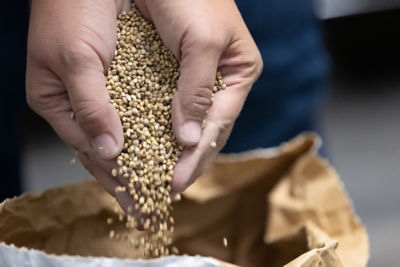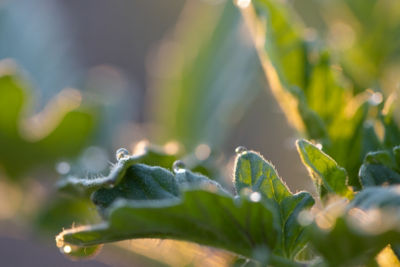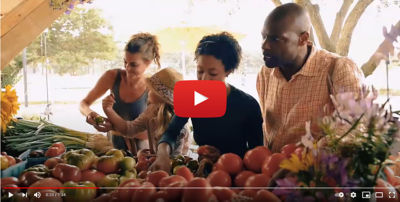Click here to download a PDF version of this Cultivation Insights article.
» Thrips parvispinus is a relatively new pest on vegetable crops in continental North America.
» Thrips parvispinus feeding on leaves and flowers can reduce yield potential and product quality.
» Cultural, biological, and chemical strategies can be used to help manage Thrips parvispinus on vegetable crops.
Thrips parvispinus, also known as pepper thrips or tobacco thrips, is native to the tropical region of southeast Asia.1,2,3,4 It has now been found in parts of Africa, Australia/Oceania, Europe, and North America. Thrips parvispinus was detected in Hawaii in the early 2000s and confirmed in Florida in 2020. It has since been detected in Georgia, Colorado, North Carlina, South Carolina, Ohio, Pennsylvania, and Ontario, Canada.1,5,6
Thrips parvispinus has a host range of over 43 plant species in 19 plant families.3,5 It is a serious pest of ornamentals and an important pest of some fruit and vegetable crops. Vegetable hosts include eggplant, pepper, potato, green bean, shallot, cucumber, watermelon, and zucchini.1,5,7
Substantial reductions in yield and market quality can result from infestations of Thrips parvispinus. Feeding by these insects can produce scars on leaves and fruit that affect the appearance and lower the marketability of the product. This is especially true for peppers, where marketable yield losses from 20 to 85% have been reported. Thrips parvispinus is considered by some to be the most economically important pest of chili pepper in India and Indonesia.2 However, in other regions, Thrips parvispinus is considered a low-threat pest. It was removed from the European and Mediterranean Plant Protection Organization (EPPO) alert list in 2001, though USDA-APHIS lists Thrips parvispinus as a “pest of concern”.2 It is a regulated pest in parts of southern Florida, where quarantines were initiated with 19 growers in March 2023.3,4
SPREAD AND ESTABLISHMENT
Thrips parvispinus can be introduced into new areas on ornamental plants or plant propagation material imported from an area where the insect is present. Shipments of tropical plants can be prime sources for introducing Thrips parvispinus into new areas. Establishment in open fields is most likely to occur in tropical and subtropical regions that do not have severely cold winters. However, the insects can survive winters on plants growing in protected culture (greenhouse) systems in areas with colder climates.2,3,4,7
IDENTIFICATION
Thrips parvispinus is one of the smallest thrips species. Adult females are up to one millimeter long, and the males are about 0.6 mm long.1,5,6 Females have dark brown to black bodies with light-colored legs and heads (Figure 1). Their wings are narrow, elongated with fringed margins, brown over the thorax, and darker over the abdomen. Males are entirely yellow. The larval stages resemble the adults but lack wings. Thrips have piercingsucking mouthparts with a stylet and mandible.
 Figure 1. The relative size of Thrips parvispinus. Ahmed Muhammad, USDA.
Figure 1. The relative size of Thrips parvispinus. Ahmed Muhammad, USDA.
LIFE CYCLE AND CONDITIONS
Thrips parvispinus has six life stages: egg, two larval stages (L1 and L2), prepupa, pupa, and adult, and the life cycle can be completed in 13 to 14 days under greenhouse conditions.1,5 The adult female deposits eggs into plant tissue, usually the bract leaves of the flowers. The eggs typically hatch within four to five days, and the larvae begin to feed on the leaves and flowers. After four or five days, the larvae drop to the soil and pupate. The prepupa and pupa stages develop in the soil, and adults emerge in as few as three days. Female adults live about nine days, while males live about six. Females typically produce about fifteen eggs during their lifetime.1,5,6
Larvae and adults hide in cracks and crevices of the plant. The adults can jump and fly short distances to nearby plants. Adults and larvae feed on pollen and suck sap from leaves and flowers. The low- and upper-temperature limits for Thrips parvispinus are 53 °F (12 °C) and 86 °F (30 °C) respectively.2,5
DAMAGE
Feeding by adults and larvae results in the formation of lightcolored spots on the affected tissues. The spots turn brown over time or develop into silver scars (Figure 2). The feeding damage to cells can cause distorted growth of leaves, flowers, and fruit, and affected leaves may drop prematurely. Growth can be stunted and uneven, and there can be swelling in plant tissues where eggs have been laid.1,2,5,8 The presence of larvae and adults on harvested products can also reduce marketability, and feeding creates sites of infection for secondary pathogens such as the fungus Cladosporium. Some references state that Thrips parvispinus is not known to be a vector for any plant viruses. However, one reference indicates that the insect can vector the tobacco streak virus.1,2,5
 Figure 2. Damage on pepper fruit caused by feeding of Thrips parvispinus.
Figure 2. Damage on pepper fruit caused by feeding of Thrips parvispinus.
Symptoms on peppers include leaves becoming papery and distorted with premature defoliation. Feeding damage can cause young leaves to roll up and become discolored. Cork-like tissue can form on leaves and fruit (Figure 2).2 Affected pepper plants can be stunted and sometimes die. Fruit yield and quality can be substantially reduced. In Florida, damage occurs most often when temperatures are above 80 °F (27 °C)
MANAGEMENT
Management decisions are often based on knowing when the insect is present in a grower’s field. For Thrips parvispinus, weekly monitoring will help allow for the early detection and timely initiation of management strategies. To detect the presence of Thrips parvispinus, randomly select plants, tap them over a white sheet of paper, and examine the paper to see if the insect is there. Yellow sticky traps can also be placed in or near the plant canopy and evaluated regularly to see if the insect is present. If transplants or other planting material is shipped in from areas where Thrips parvispinus is known to be present and overwinter, the plant material should be isolated in a separate area until it can be inspected for insects and characteristic symptoms.1,2,5
Because Thrips parvispinus is a relatively new pest in North America, recommended management strategies are currently based on the measures used to manage other thrips species, such as the western flower thrips.1,2 Cultural practices include the use of insect-free transplants, the rapid removal of infested plants and plant debris, control of weed hosts, and the use of insect netting or row covers to exclude the insect. Early planting of bell peppers can help avoid infestation while the plants are young and developing.
Natural enemies, including predatory mites, green lacewings, minute pirate bugs, and entomopathogenic nematodes, have shown some ability to manage Thrips parvispinus in some studies, but they may be difficult to establish, especially in openfield production systems.1,2,5
The primary strategy for managing Thrips parvispinus is the application of insecticides. Effective application can be difficult as complete coverage of affected tissues is necessary to help attain acceptable levels of control.2 One study found that L1 larvae were more susceptible to insecticides than L2 larvae and adults.9 Thrips parvispinus has been an agricultural problem in India and Indonesia for several years, and insecticides have been used and evaluated in those regions.
While Thrips parvispinus has been present in Hawaii for about twenty years, it has only recently become a problem in the continental U.S. and Canada. Therefore, fewer studies have been done in North America.9 One study found that spinosad was more effective than a neonicotinoid insecticide for the management of Thrips parvispinus in field and greenhouse environments, and instances of pesticide resistance have been reported for Thrips parvispinus.3,6 Regional vegetable production and pest management guides often include recommendations for managing thrips in specific vegetable crops, sometimes mentioning specific thrips species, such as western flower thrips, and listing registered insecticides.10 It is important to read the specific product labels because some products use the general term “thrips” while others list specific thrip species. Because of the relatively recent arrival of Thrips parvispinus in the continental U.S., this species may not currently be listed on product labels.
SOURCES
1 Prade, P. 2013. Invasive insect: Thrips parvispinus. Penn State Extension. https://extension.psu.edu/invasive-insect-thrips-parvispinus.
2 Pijnakker, J. 2023. Thrips parvispinus (tobacco thrips). CABI, Online Datasheet 53744. https://www.cabidigitallibrary.org/doi/epdf/10.1079/cabicompendium.53744.
3 Jandricic, S., Summerfield, A., 2022. New thrips, new problems: Thrips parvispinus intercepted in Ontario. Greenhouse Canada. https://www.greenhousecanada.com/new-thrips-new-problems/.
4 Jandricic, S. 2023. Thrips parvispinus (“pepper thrips”): The importance of inspecting plants and dipping cuttings from florida. ONfloriculture. https://onfloriculture.com/2023/04/18/thrips-parvispinus-pepper-thrips-the-importanceof-inspecting-plants-and-dipping-cuttings-from-florida/.
5 Joseph, S. 2023. Watch for Thrips parvispinus in Georgia. University of Georgia, Turf and Ornamental Pest Management. https://site.caes.uga.edu/entomologyresearch/2023/04/watch-for-thrips-parvispinus-in-georgia/.
6 Ahmed, M.Z., Revynthi, A.M., McKenzie, C.L., and Osborne, L.S. 2023. Thrips parvispinus (Karny), an emerging invasive regulated pest in the United States. https://mrec.ifas.ufl.edu/lsolab/thrips/thrips-parvispinus/.
7 The Netherlands Plant Protection Organization. 2019. Thrips parvispinus. Quick scan, QS.Ent./2019/001.
8 Soto-Adames, F. 2020. Thrips parvispinus (Karny). Pest Alert, Florida Department of Agriculture and Consumer Services. FDACS-P-01926.
9 Revynthi, A., Vargas, G., Ataide, L., Velazquez-Hernandez, Y., Canon, M., Reyes, I., Villamarin, P., and Green, A. 2023. Efficacy of contact insecticides against Thrips parvispinus under laboratory conditions. University of Florida Tropical Research and Education Center. Presentation May 4, 2023.
10 Dittmar, P., Agehara, S., and Dufault, N. (Eds.) 2023-2024. Vegetable Production Handbook of Florida. UF-IFSA Extension.
Websites verified 2/23/2024
ADDITIONAL INFORMATION
For additional agronomic information, please contact your local seed representative.
Performance may vary, from location to location and from year to year, as local growing, soil and weather conditions may vary. Growers should evaluate data from multiple locations and years whenever possible and should consider the impacts of these conditions on their growing environment. The recommendations in this article are based upon information obtained from the cited sources and should be used as a quick reference for information about greenhouse cucumber production. The content of this article should not be substituted for the professional opinion of a producer, grower, agronomist, pathologist and similar professional dealing with this specific crop.
BAYER GROUP DOES NOT WARRANT THE ACCURACY OF ANY INFORMATION OR TECHNICAL ADVICE PROVIDED HEREIN AND DISCLAIMS ALL LIABILITY FOR ANY CLAIM INVOLVING
SUCH INFORMATION OR ADVICE.
5015_370703 Published 03/07/2024



